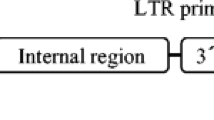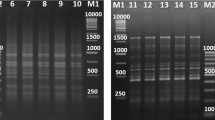Abstract
Black pepper is one of the most important spices, known for its use worldwide. Retrotransposons, class I mobile elements abundantly appear in the plant genome and can play role in gene activation or silencing by their copy and paste mechanism in the respective genome of an organism. In this study, the Piper nigrum L. genome was scanned for identification of retrotransposon activity in terms of insertional polymorphism using IRAP retrotransposon-based molecular marker system. Seven LTR IRAP primers (Sukkula, Nikita, 3′LTR, 5′LTR1, 5′LTR2, LTR6149, and LTR6150) in single and combination were used to analyse insertional polymorphism among nineteen varieties of black pepper. In single primer analysis Sukkula, Nikita, 3′LTR, and LTR6150 primers showed amplification in all the nineteen varieties. Out of these Sukkula, Nikita and 3′LTR were found to be polymorphic in nature with 33.33%, 53% and 56.25% polymorphism, with PIC values of 0.131, 0.183 and 0.197 respectively. Out of the 21 combinations of primer pairs tried, 16 showed amplification in all the nineteen varieties and 14 combinations among them were polymorphic in nature with the percentage of polymorphism and PIC value in the range between 50–100% and 0.04–0.350 respectively. This is the first report of horizontal transferability and identification of retrotransposons Sukkula, BARE1, and Nikita in black pepper (Piper nigrum L.) indicating an evolutionary relationship between black pepper (Piper nigrum L.) and other genome such as barley (Hordeum vulgare). These polymorphic markers (single and combination of primer pairs) were also useful for the evaluation of genetic diversity among the nineteen varieties of black pepper used in the study.






Similar content being viewed by others
References
Abirami K, Baskaran V, Simachalam P (2018) ISSR marker-based diversity assessment of Piper spp. in Bay Island, India. Indian J Agric Res 52(4):434–438
Alavi-Kia SS, Mohammadi SA, Aharizad S, Moghaddam M (2008) Analysis of genetic diversity and phylogenetic relationships in Crocus genus of Iran using inter retrotransposon amplified polymorphism. Biotechnol Biotechnol Equip 22(3):795–800
Arabi ME, Jawhar M (2012) Inter-retrotransposon amplified polymorphism (IRAP) markers for genetic diversity assessment of Pyrenophora graminea. J Plant Bio Res 1(4):138–144
Babu KN, Ravindran PN (1992) Improved varieties of black pepper. In: Sarma YR, Devasahayam S, Anandaraj M (eds) Black pepper and cardamom. Indian Society for Spices, Kozhikode, pp 61–64
Basirnia A, Darvishzadeh R, Mandoulkani BA (2016) Retrotransposon insertional polymorphism in sunflower (Helianthus annuus L.) lines revealed by IRAP and REMAP markers. Plant Biosyst 150:641–651
Branco CJS, Vieira EA, Malone G, Kopp MM, Malone E, Bernarndes A, Mistura CC, Carvalho FIF, Oliveira CA (2007) IRAP and REMAP assessments of genetic similarity in rice. J Appl Genet 48:107–113
Cakmak B, Marakli S, Gozukirmizi N (2015) SIRE1 retrotransposons in barley (Hordeum vulgare L.). Genetika 51(7):775–786
Cakmak B, Marakli S, Gozukirmizi N (2017) Sukkula retrotransposon movements in the human genome. Biotechnol Biotechnol Equip 31(4):756–760
Cheraghi A, Rahmani F, Ghorttapeh AH (2018) IRAP and REMAP based genetic diversity among varieties of Lallemantia iberica. Mol Biol Res Commun 7(3):125–132
Elkina MA, Erkenov TA, Glazko VI (2015) Mobile genetic elements as a tool for the analysis of genetic differentiation of varieties of cultivated plants and breeds of farm animals. IJRSR 6:5893–5900
Fan F, Cui B, Zhang T, Ding J, Wen X (2014) LTR-retrotransposon activation, IRAP marker development and its potential in genetic diversity assessment of masson pine (Pinus massoniana). Tree Genet Genomes 10:213–222
Fatmawati Y, Setiawan AB, Purwantoro A, Respatie DW, Teo CH (2021) Analysis of genetic variability in F2 interspecific hybrids of mung bean (Vigna radiata) using inter-retrotransposon amplified polymorphism marker system. Biodiversitas 22(11):4880–4889
Finnegan DJ (1989) Eukaryotic transposable elements and genome evolution. Trends Genet 5:103–107
Fortune PM, Roulin A, Panaud O (2008) Horizontal transfer of transposable elements in plants. Commun Integr Biol 1(1):74–77
Haerinasab M, Farouji AE (2022) Contribution to the knowledge of the genetic diversity and taxonomy of some Iranian Trifolium species. Genet Resour Crop Evol 69:699–717
Hosseini M, Yassaie M, Rashed-Mohasse MH, Ghorbani R, Niazi A (2022) Genetic diversity of Iranian wild barley (Hordeum spontaneum Koch.) populations. J Crop Sci Biotechnol 25:301–311
Igiebor FC, Marakli S, Gozukirmizi N (2016) Effects of cadmium on Sukkula retrotransposon polymorphism in Ailanthus altissima (Mill.) Swingle. J Mol Biol Genet 1:33–36
Kalendar R (2011) The use of retrotransposon-based molecular markers to analyze genetic diversity. Ratar Povrt Field Veg Crop Res 48:261–274
Kalendar R, Schulman AH (2006) IRAP and REMAP for retrotransposon-based genotyping and fingerprinting. Nat Prot 1(5):2478–2484
Kalendar R, Grob T, Regina M, Suoniemi A, Schulman A (1999) IRAP and REMAP: two new retrotransposon-based DNA fingerprinting techniques. Theor Appl Genet 98:704–711
Khaleghi E, Sorkheh K, Chaleshtori MH, Ercisli S (2017) Elucidate genetic diversity and population structure of Olea europaea L. germplasm in Iran Using AFLP and IRAP molecular markers. 3 Biotech 7(1):71
Kumar BM, Sasikumar B, Kunhamu TK (2021) Agroecological aspects of black pepper (Piper nigrum L.) cultivation in Kerala: a review. AGRIVITA J Agric Sci 43(3):648–664
Kumari R, Wankhede DP, Bajpai A, Maurya A, Prasad K et al (2019) Genome wide identification and characterization of microsatellite markers in black pepper (Piper nigrum): a valuable resource for boosting genomics applications. PLoS ONE 14(12):e0226002
Leigh F, Kalendar R, Lea V, Lee D, Donini P, Schulman AH (2003) Comparison of the utility of barley retrotransposon families for genetic analysis by molecular marker techniques. Mol Gen Genomics 269:464–474. https://doi.org/10.1007/s00438-003-0850-2
Mamaghani RA, Mohammadi SB, Aharizad S (2015) Transferability of barley retrotransposon primers to analyse genetic structure in Iranian Hypericum perforatum L. population. Turk J Bot 39(4):664–672
Mandoulakani BA, Sadigh P, Azizi H, Piri Y, Nasri S, Arzahang S (2015) Comparative assessment of IRAP, REMAP, ISSR, and SSR markers for evaluation of genetic diversity of alfalfa (Medicago sativa L.). J Agr Sci Technol 17:999–1010
Mansour A (2008) Utilization of genomic retrotransposon as cladistic molecular marker. J Cell Mol Boil 7(1):17–28
Marakli S (2018) Transferability of barley retrotransposons (Sukkula and Nikita) to investigate genetic structure of Pimpinella anisum L. Marmara Fen Bilimleri Dergisi 3:299–304
Marakli S (2019) Retrotransposon analyses in Cucurbitaceae family. Int J Sci Lett 1(1):68–76
Mia S, Ahmed NU, Islam MZ, Rashad MI, Islam M, Zaman M (2022) Genetic diversity and yield performance among T. Aman rice (Oryza sativa L.) landraces in Barishal region of Bangladesh. J Crop Sci Biotechnol 25:123–132
Nazeem PA, Kesavachandran R, Babu TD, Achuthan CR, Girija D, Peter KV (2005) Assessment of genetic variability in black pepper (Piper nigrum L.) varieties through RAPD and AFLP analysis. In: Proceeding of national symposium on biotechnological interventions for improvement of horticultural crops: issues and strategies, Trissur, Kerala, pp 226–228
Nisha J, Abraham Z, Soniya EV (2007) A preliminary assessment of genetic relationships among agronomically important cultivars of black pepper. BMC Genet 8:42
Otwe EP, Agyirifo DS, Galyuon IK, Heslop-Harrison JS (2017) Molecular diversity in some Ghanaian cowpea [Vigna unguiculata L. (Walp)] accessions. Trop Plant Biol 10:57–67
Pradeepkumar T, Karihaloo JL, Archak S, Baldev A (2003) Analysis of genetic diversity in Piper nigrum L. using RAPD markers. Genet Resour Crop Evol 50:469–475
Rashid K, Othman RY, Ali BS, Yusof YM, Nezhadahmadi A (2014) The application of Irap marker in the breeding of Papaya (Carica papaya L.). Indian J Sci Technol 7(11):1720–1728
Roldán-Ruiz I, Calsyn E, Gilliland TJ, Coll R, van Eijk MJT, Loose MD (2000) Estimating genetic conformity between related ryegrass (Lolium) varieties. 2. AFLP characterization. Mol Breed 6:593–602
Saeidi H, Rahiminejad MR, Harrison JS (2008) Retroelement insertional polymorphism, diversity and phylogeohraphy within diploid, D genome Aegilops tauschii (Triticeae, Poaceae) sub taxa in Iran. Ann Bot 101(6):855–861
Saleh B (2013) Genetic diversity in Ficus sycomorus L. species (Moraceae) using RAPD and IRAP markers. Agriculture (poľnohospodárstvo) 59(3):120–130
Saraswathi SM, Uma S, Ramaraj S, Durai P, Mustaffa MM, Kalaiponmani K, Chandrasekar A (2019) Inter retrotransposon based genetic diversity and phylogenetic analysis among the Musa germplasm accessions. J Plant Biochem Biotechnol 29(1):114–124
Sheidai M, Riazifar M, Hoordadian A, Alishah O (2018) Genetic fingerprinting of salt and drought-tolerant cotton cultivars (Gossypium hirsutum) by IRAP-REMAP and SRAP molecular marker. Plant Gene 14:12–19
Shivashankar M (2014) Genetic diversity and relationships of piper species using molecular marker. Int J Curr Microbiol Appl Sci 3:1101–1109
Soengas P, Velasco P, Padilla G, Ordas A, Cartea ME (2006) Genetic relationships among Brassica napus crops based on SSR markers. Horticult Sci 41(5):1195–1199
Sreedevi M, Syamkumar S, Sasikumar B (2005) Molecular and morphological characterization of new promising black pepper (Piper nigrum L.) lines. J Spices Aromat Crops 14(1):1–9
Srinivasan K (2007) Black pepper and its pungent principle Piperine: a review of diverse physiological effects. Crit Rev Food Sci Nutr 47(8):735–748
Strioto DK, Kuhn BC, Nagata WS, Marinelli G, Oliveira-Collet SA, Mangolin CA, Machado MF (2019) Development and use of retrotransposons-based markers (IRAP/REMAP) to assess genetic divergence among table grape cultivar. Plant Genet Resour 17(3):272–279
Subba A, Alex S, Soni KB, Nair DS, Reghunath BR (2014) Isolation of genomic DNA from mature leaves and spikes of black pepper (Piper nigrum L.). J Plant Sci Res 30(1):21–25
Sun J, Yin H, Li L, Song Y, Fan L, Zhang S, Wu J (2015) Evaluation of new IRAP markers of pear and their potential application in differentiating bud sports and other Rosaceae species. Tree Genet Genomes 11(2):25
Taheri MT, Alavi-Kia SM, Mohammadi SA, Vahed MM (2018) Assessment of genetic diversity and relationships among Triticum urartu and Triticum boeoticum populations from Iran using IRAP and REMAP markers. Genet Resour Crop Evol 65:1867–1878
Teo CH, Tan SH, Ho CL, Faridah QZ, Othman YR, Heslop-Harrison JS, Kalendar R, Schulman AH (2005) Genome constitution and classification using retrotransposon-based marker in the orphan crop banana. J Plant Biol 48(1):96–105
Todorovska E (2007) Retrotransposons and their role in plant-genome evolution. Biotechnol Biotechnol Equip 21(3):294–305
Varagona MJ, Purugganan M, Wessler SR (1992) Alternative splicing induced by insertion of retrotransposon into the maize waxy gene. Plant Cell 4:811–820
Varghese JM, Bhat AI (2011) An efficient Agrobacterium-mediated transformation protocol for black pepper (Piper nigrum L.) using embryogenic mass as explant. J Crop Sci Biotechnol 14(4):247–254
Vernhettes S, Grandbastien MA, Casacuberta JM (1998) The evolutionary analysis of the Tnt1 retrotransposon in Nicotiana species reveals the high variability of its regulatory sequences. Mol Biol Evol 15(7):827–836
Vuorinen AL, Kalendar R, Fahima T, Korpelainen H, Nevo E, Shulman AH (2018) Retrotransposon based genetic diversity assessment in wild emmer wheat (Triticum turgidum spp. dicoccoides). Agronomy 8:107
Widyawan MB, Wulandary S, Taryono, (2020) Genetic diversity analysis of yardlong bean genotypes (Vigna unguiculata subsp. sesquipedalis) based on IRAP marker. Biodiversitas 21(3):1101–1107
Zanganeh F, Sheidai M (2022) Population genetic diversity and genetic affinity analyses of sweet orange cultivars (Citrus sinensis (L.) Osbeck) by using IRAP molecular markers. Genet Resour Crop Evol 69:2437–2446
Acknowledgements
Kerala Agricultural University is gratefully acknowledged for providing facilities for the conduct of the work and ICAR Indian Institute of Spices and Research (IISR), Kozhikode, Kerala for providing plant samples.
Funding
This study was funded by Kerala Agricultural University, Thiruvananthapuram, Kerala, India.
Author information
Authors and Affiliations
Corresponding author
Ethics declarations
Conflict of interest
The authors declare that they have no conflict of interest. All the authors have read and approved the manuscript in its final form.
Additional information
Publisher's Note
Springer Nature remains neutral with regard to jurisdictional claims in published maps and institutional affiliations.
Rights and permissions
Springer Nature or its licensor (e.g. a society or other partner) holds exclusive rights to this article under a publishing agreement with the author(s) or other rightsholder(s); author self-archiving of the accepted manuscript version of this article is solely governed by the terms of such publishing agreement and applicable law.
About this article
Cite this article
Dongare, M.D., Alex, S., Soni, K.B. et al. Cross-species transferability of IRAP retrotransposon markers and polymorphism in black pepper (Piper nigrum L.). Genet Resour Crop Evol 70, 2593–2605 (2023). https://doi.org/10.1007/s10722-023-01590-z
Received:
Accepted:
Published:
Issue Date:
DOI: https://doi.org/10.1007/s10722-023-01590-z




